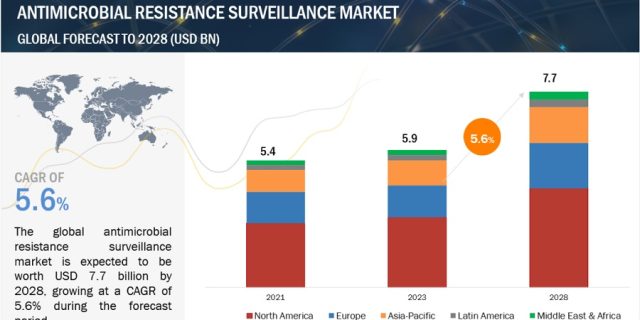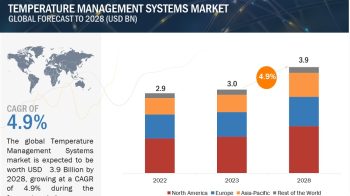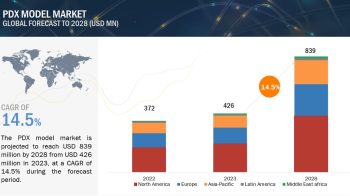
The global antimicrobial resistance surveillance market is projected to reach USD 7.7 billion by 2028 from USD 5.9 billion in 2023, at a CAGR of 5.6% during the forecast period. Growth in this market is majorly driven by factors such as the growing prevalence of infections caused by drug-resistance pathogens, innovations in diagnostic technologies and growing government initiatives to combat antimicrobial-resistance species.
Download a PDF Brochure: https://www.marketsandmarkets.com/pdfdownloadNew.asp?id=21323165
Antimicrobial Resistance Surveillance Market by Solution (Kits, System, Surveillance Software, Service), Application (Clinical Diagnostics, Public Health Surveillance), End User (Hospitals, Clinics, Academic, Research Institutes) – Global Forecast to 2028
The prominent players in this market are Becton, Dickinson and Company (US), Biomerieux (France), Thermo Fisher Scientific (US), Danaher (US), Luminex Corporation (US), Bruker (US), Merck KgaA (Germany), Bio-Rad (US), Qiagen (Germany), Abbott Laboratories (US), Roche Diagnostics (Switzerland), OpGen, Inc. (US), Wolters Kluwer N.V. (US), Lumed (US), BioSpace (US), Cepheid (US), Accelerate Diagnostics, Inc. (US), Liofilchem S.r.l. (Italy), Alifax S.r.l. (Italy), and Bioanalyse (Turkey).
The global market for antimicrobial resistance surveillance is categorized into different solutions, including diagnostic kits, diagnostic systems, surveillance software, and services. In 2023, the dominant portion of this market is held by the diagnostic kits segment. This prominence is mainly a result of the growing need for swift and precise tools for identifying antimicrobial resistance. These diagnostic kits play a crucial role in identifying the existence of bacteria resistant to antimicrobial agents within clinical samples like blood, urine, and respiratory secretions.
Categorized by its applications, the global market for antimicrobial resistance surveillance is divided into clinical diagnostics, public health surveillance, and other uses. For the year 2023, it is projected that the clinical diagnostics segment will hold the most significant portion of the global antimicrobial resistance surveillance market. This expansion within the segment is linked to several factors, including the escalating occurrence of antimicrobial resistance, the imperative to enhance patient outcomes, the utility in determining bacteria’s susceptibility to diverse antimicrobial agents. This information is crucial for healthcare providers to make well-informed choices regarding the treatment of patients afflicted with infections resistant to antimicrobial treatments.
Categorized by their end users, the global market for antimicrobial resistance surveillance is divided into hospitals & clinics, research and academic institutes, and other entities. For the year 2023, it is anticipated that the hospitals & clinics segment will hold the most substantial portion of the global antimicrobial resistance surveillance market. The prevalence of this segment can be attributed to its crucial role at the frontline of patient care, infection management, and data generation. Furthermore, hospitals & clinics are obligated to undertake surveillance of antimicrobial resistance as an integral part of their operations.
Categorized by geographical regions, the antimicrobial resistance surveillance market is divided into North America, Europe, Asia Pacific, Latin America, and the Middle East Africa. In the year 2023, it is projected that the North American sector of the antimicrobial resistance surveillance market will hold the most significant portion. This prominence can be ascribed to several factors, including the existence of prominent market participants, heightened consciousness regarding antimicrobial resistance surveillance, and a robust regulatory framework.
This study involved the extensive use of both primary and secondary sources. The research process involved the study of various factors affecting the industry to identify the segmentation types, industry trends, key players, competitive landscape, key market dynamics, and key player strategies.
Secondary Research
This research study involved the use of comprehensive secondary sources; directories and databases such as D&B, Bloomberg Business, and Factiva; and white papers, annual reports, and companies’ house documents. Secondary research was used to identify and collect information for this extensive, technical, market-oriented, and commercial study of the antimicrobial resistance surveillance market. It was also used to obtain important information about the top players, market classification, and segmentation according to industry trends to the bottom-most level, geographic markets, technology perspectives, and key developments related to the market. A database of the key industry leaders was also prepared using secondary research.
Primary Research
In the primary research process, various sources from both the supply and demand sides were interviewed to obtain qualitative and quantitative information for this report. Primary sources from the supply side and demand side are detailed below. Industry experts such as CEOs, presidents, vice presidents, directors, marketing directors, marketing managers, and related executives from various key companies and organizations in the antimicrobial resistance surveillance industry were interviewed to obtain and verify both the qualitative and quantitative aspects of this research study. A robust primary research methodology has been adopted to validate the contents of the report and fill in the gaps.


